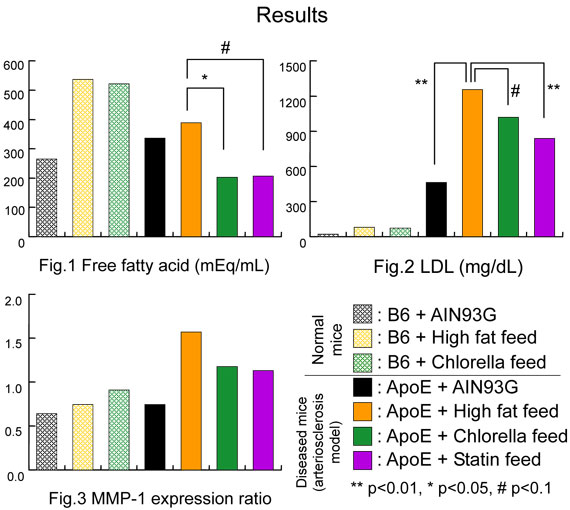- TOP
- List of reports
- Activity of Chlorella in animal models of arteriosclerotic diseases
Activity of Chlorella in animal models of arteriosclerotic diseases
【Scientific information】
Research and Development Department, Sun Chlorella Corporation
Activity of Chlorella in animal models of arteriosclerotic diseases
Findings of this study were presented at the 62nd Meeting of the Japanese Society of Nutrition and Food Science (2008)
- Study Objectives
- We have thus far reported on improvement by Chlorella of metabolic syndrome as well as its anti-inflammatory activity. Based on these findings, ingestion of Chlorella is also expected to be effective against arteriosclerotic diseases that develop in combination with progression of metabolic syndrome and inflammation. We therefore studied the efficacy of Chlorella in the APoE-deficient miceNote 1), a model of arteriosclerotic disease, and C57BL/6 mice, which are normal.
- Method and experiments
- Mice were divided into four groups by different types of feed such as Control Feed comprising basic feed AIN93G, High-Fat Feed (Control Feed plus fat), Chlorella Feed (High-Fat Feed containing 5% Chlorella), and Statin Feed (High-Fat Feed containing 0.2% of simvastatin), which is used in the treatment of hyperlipidemia and other diseases. Each type of feed was administered to ApoE-deficient mice for 12 weeks. For normal mice, three groups other than the Statin Feed Group were established. At the end of the study, serum components were measured with a real-time RT-PCR methodNote 2), as well as visceral fat, the weight of the liver, and three types of gene groups related to arteriosclerotic diseases selected from a site in the thoracic aorta, i. e., IL-6, MCP-1, and MMP-1. In addition, the tissues of the thoracic aorta were stained by hematoxylin-eosin and observed under a microscope.
- Results
- Compared with the Control Feed Group, the mice in the High Fat Feed Group exhibited increases in body weight, free fatty acid (FFA) and LDL values. ApoE-deficient mice given Chlorella Feed, however, had FFA and LDL levels of 202.8 mEq/mL and 1,017.8 mg/dL, respectively, indicating suppression of these increases compared with the High Fat Feed Group values of 389.0 mEq/mL and 1,254.0 mg/dL (Figures 1 and 2). The Control Feed Group and the Statin Feed Group exhibited more or less similar findings with respect to visceral fat and liver weight. With administration of Chlorella Feed, we found that thoracic aorta IL-6 and MCP-1 levels were high values compared with those in other groups, whether mice were diseased or normal. Although the level of MMP-1 increased slightly in normal mice, the ApoE-deficient mice exhibited a lower value than the Cholesterol Feed Group, and a value similar to that in the Statin Feed Group. Although microscopic observation of the thoracic aorta tissues revealed slight differences 3-2 between ApoE-deficient mice and normal mice, no differences were observed by type of feed administered. As a result, administration of Chlorella exhibited a tendency to suppress increase in FFA, total cholesterol including LDL, and visceral fat, as well as a tendency to decrease the expression of MMP-1, which indicates the degree of progression of arteriosclerotic diseases, suggesting that Chlorella delays the progression of arteriosclerosis (Fig. 3). Regardless of the type of mice, increases in the expression of IL-6 and MCP-1 were observed, suggesting the possibility that induction of macrophages, which are one type of immune cell, had increased, enhancing immunity as a result.

Terminology
- Note 1) Detailed particular of ApoE-deficient mice
- These mice are not capable of producing a type of protein called ApoE which carries cholesterol, fatty acids, and other substances in the blood to the liver. For this reason, if these mice ingest feed containing an abundance of cholesterol, their blood cholesterol level rises, inducing arteriosclerosis as a result. They are therefore used in study as models of arteriosclerotic diseases.
- Note 2) Detailed particular of real-time RT-PCR method
- This technique quantifies the activity of target genes. It involves continuous observation and measurement of the reactions observed in PCR, which is a method of amplifying genes.
Presented at a scientific meeting
- Academic society: meeting
- The 62nd Meeting of the Japanese Society of Nutrition and Food Science, 2008
- Title:
- Chlorella's actions in animal models of arteriosclerotic diseases
- Authors:
- Tohru Masuzawa1), Takuma Nakajima1), Masaki Fujishima2), Yukari Arakawa2), Tohru Mizoguchi2), Noriyuki Yamazaki1)
- Affiliation:
- 1) NDDRC, Inc., 2) Sun Chlorella Corporation





